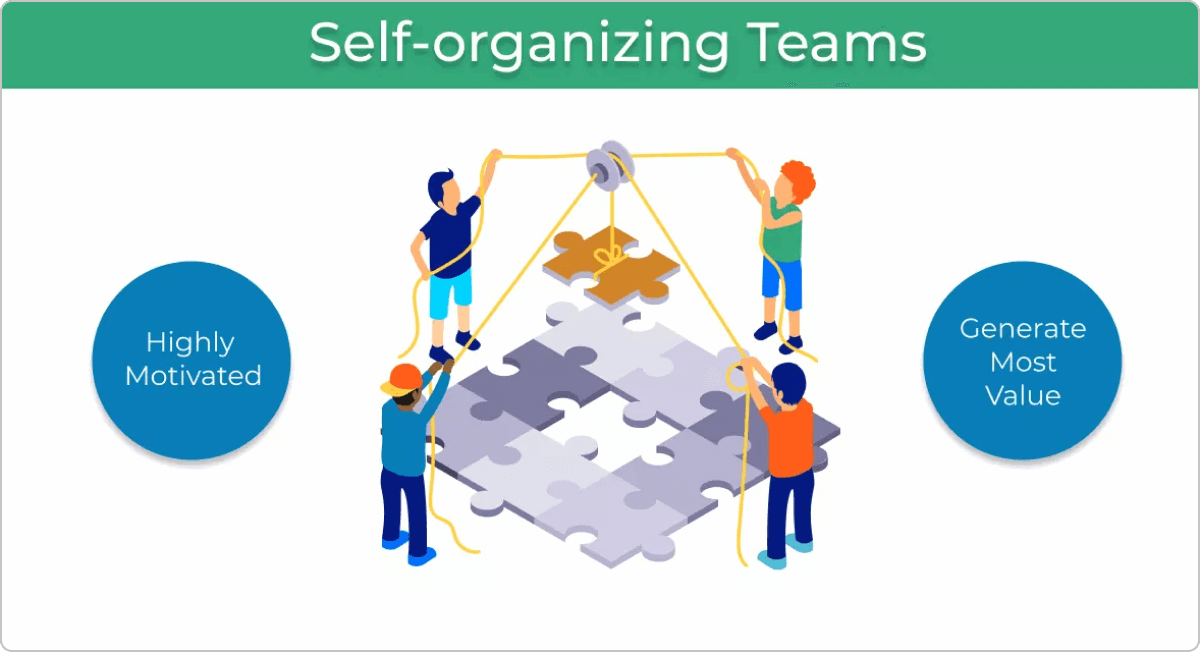In the dynamic world of project management, having a team that’s both agile and responsive can make all the difference. A self-organizing team embodies this idea, with skilled professionals who take charge of managing and executing their work. While this concept might sound modern, it actually dates back to post-World War II Japan, when the economy needed efficient production strategies. The recent rise of the Agile movement has brought self-organizing teams into the spotlight, making them a key part of modern project management.
Let’s dive into why self-organizing teams are so important and how they can transform your business in today’s competitive landscape.
What Is a Self-Organizing Team?
A self-organizing team is a group of professionals who have the freedom to decide how they manage and carry out their work. They focus on aligning their efforts with the technical details and the needs of the customer.
This approach, which has its roots in the Toyota Production System (TPS), revolutionized manufacturing by focusing on waste elimination and adopting a "pull" system over a "push" system. The TPS highlighted the importance of harnessing individual expertise and innovation while ensuring that team members work toward common objectives. As highlighted in his book TPS Beyond Large-Scale Production, Taiichi Ohno defines: "A championship team combines good teamwork with individual skill."
The core of self-organizing teams is giving power to those directly involved in the work. When team members have the authority to make decisions, they can use their deep understanding of the tasks to guide their efforts. This sense of empowerment boosts morale and efficiency, creating an environment where delivering great value to the customer becomes a natural result.
Why Self-Organization Is Key for Agile Teams
Self-organization is a crucial quality of Agile teams because it allows for quick and frequent value delivery to the market. In an Agile environment, team members have the freedom to apply their expertise without being micromanaged. This respect for individual skills boosts motivation and enhances efficiency, leading to faster and more frequent releases of working solutions for customers.

The 6 Key Components of Self-Organizing Teams
Self-organizing teams thrive by embracing a set of essential pillars that collectively promote autonomy, efficiency, and innovation. Here are the six main elements that support their success:
1. Expertise
For a self-organizing team to function effectively, each member must bring expertise and a solid understanding of project management. Team members need to manage their time well and fully understand the work process. Cross-functionality is also vital, allowing team members to support one another and tackle various tasks as needed.
2. Focus on Collaboration and Teamwork
Collaboration is at the heart of self-organizing teams. These teams prioritize teamwork over individual achievements, fostering an open and supportive environment. Success is a collective effort, and team members are expected to show empathy, share knowledge freely, and work together toward common goals.
3. Motivation
Motivation (including self-accountability) is another key trait of self-organizing teams. Instead of waiting for assignments from management, team members take the initiative to start their work and even suggest new ideas when there’s nothing planned. This requires high self-motivation, accountability, and a strong commitment to the team’s shared vision.
4. Trust and Respect
Trust and respect are fundamental in self-organizing teams. Team members actively listen to each other and make decisions based on data, not opinions. The cross-functional nature of these teams builds trust that everyone will get the job done. When someone encounters a challenge or needs help, they’re encouraged to ask for assistance or take time to learn.
5. Continuous Improvement
Continuous improvement is crucial for enhancing the performance and value delivery of self-organizing teams. Agile managers encourage team members to use downtime for learning, focusing on growth rather than just task completion. This approach strengthens the team’s autonomy and confidence, fostering ongoing competence development.
6. Sense of Ownership and Commitment
Ownership and commitment are essential in self-organizing teams. Team members must be accountable for their tasks and communicate any obstacles promptly so they can be addressed. A shared purpose is central to self-organization, with Agile project managers playing a key role in fostering and communicating this collective goal.
How Do Self-Organizing Teams Work in Practice?
✔ Collaborative Task Planning: Self-organizing teams work by engaging in collaborative sessions (meetings) to plan their own tasks. Instead of waiting for a manager to distribute a set of work assignments, self-organizing teams usually visualize their work in backlogs and sit together to determine how to organize what needs to be done best.
 Visualization of a scrum process on a kanban board in Businessmap
Visualization of a scrum process on a kanban board in Businessmap
✔ Routine Planning Sessions: In self-organizing teams, members regularly come together in planning sessions to agree on work priorities and decide who will handle what. Whether working in scheduled increments or continuously delivering tasks, these meetings are crucial to ensuring everyone is on the same page. Team members are free to approach their tasks as they see fit, with minimal supervision. This autonomy not only cuts down on micromanagement but also significantly boost productivity.
✔ The Evolving Role of Project Managers: It's important to mention that project managers do not disappear from self-organizing teams. However, their role shifts. They focus on managing the work instead of the workers, prioritizing team projects, collecting customer feedback, communicating the strategic goals and vision, and being the connective tissue between the team(s) and top-level management.
What Emerges from a Self-Organizing Team?
When you work in a self-organizing team, some of the best ideas, designs, and solutions naturally come to life. The 11th Agile principle highlights this by saying, "the best architectures, requirements, and designs emerge from self-organizing teams." This means that instead of having management dictate every step, your team members are actively involved in planning and can decide how to get the work done. It makes sense because they have the expertise to create value for the customer directly. When your skills are trusted, you feel valued, often leading to higher-quality products and services.

How to Create Self-Organizing Teams?
Renowned coaching expert Ro Gorell points out that self-organizing teams don’t just happen by chance. In her book "Coaching Self-Organising Teams," she highlights the practical steps needed, from choosing the right tools to defining roles and building a trusting environment.
With that in mind, creating a self-organizing team depends on three key elements essential for their success:
1. Invest in Training: Provide your team with the necessary skills and knowledge. Foster self-growth and proficiency in Agile project management, as well as the soft skills needed for a shift from solo performance to team synergy.
2. Embrace Coaching: Just as a garden needs a gardener, a self-organizing team benefits from the guidance of Agile coaches. These experts provide direction in planning and structuring work and help teams develop their collaborative skills. Over time, teams will grow to sustain themselves, reducing their reliance on external coaching.
3. Provide Mentoring: Ongoing mentorship is essential to ensure the garden flourishes. Whether it's an Agile coach or a seasoned team member with leadership qualities, a mentor helps navigate challenges and maintain the delicate balance between autonomy and order.
Traditional vs. Agile Teams
Comparing the core characteristics of traditional teams and those of Agile self-organizing teams highlights the differences in structure, management, and overall approach to work.
| Aspect | Traditional Team | Agile Self-Organizing Team |
| Leadership | Top-down management | Shared leadership and decision-making |
| Project Management | Top-down project management with tight control over planning and execution | Collaborative planning with team members making execution decisions |
| Team Autonomy | Limited autonomy due to micromanagement | High autonomy to encourage ownership |
| Team Structure | Functional silos with distinct roles | Cross-functional teams with overlapping skills |
| Work Delivery | Execution strictly according to the plan | Adaptive execution with the flexibility to change course based on feedback |
| Customer Value | Focus on meeting pre-defined expectations | Continuous delivery of value with work closely aligned to actual customer needs and feedback |
What Are the Challenges Faced by the Self-Organizing Teams?
Some of the main challenges faced by self-organizing teams are listed below.
- Resistance: When turning from a traditional team structure to self-organization, you might face opposition from project managers or some senior team members.
- Lack of Self-Management Skills: Team members might lack self-management skills, making the transition to self-organization difficult.
- Team Conflicts: Due to the team's autonomy, there is a good chance that more team members will have separate opinions, leading to disputes.
- Absence of Individual Accountability: Some people might be less accountable than others to do their work, which can cause an imbalance in the team.
Self-Organization: A Continuous Learning Process
Self-organization is a dynamic learning journey that intertwines the Lean principles of continuous improvement and respect for people with Agile project management methods. This approach acknowledges the intrinsic value and expertise of each team member, fostering an environment where individuals are empowered to take the initiative and contribute to the collective workflow management.
By embracing the Lean concept, self-organizing teams continuously seek ways to streamline processes and enhance efficiency, all while maintaining a deep respect for the human element at the core of their operations. Agile principles further enrich this landscape by promoting adaptability and customer-centric development, ensuring that teams remain responsive and innovative. What emerges from self-organizing teams as a result - a fertile ground for growth, where learning is an ongoing process and improvement is a shared responsibility, ultimately leading to more effective and resilient project management.
Try Businessmap Free for 14 days
Nikolay Tsonev
Product Marketing | PMI Agile | SAFe Agilist certified
Nick is a seasoned product marketer and subject matter expert at Businessmap, specializing in OKRs, strategy execution, and Lean management. Passionate about continuous improvement, he has authored numerous resources on modern-day management. As a certified PMI practitioner and SAFe Agilist, Nick frequently shares his insights at Lean/Agile conferences and management forums.



